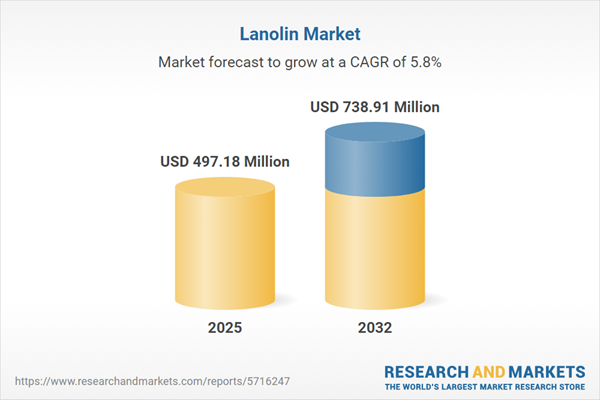Speak directly to the analyst to clarify any post sales queries you may have.
Senior decision-makers in the lanolin market are navigating significant transformation, characterized by rising demand for sustainable sourcing, compliance complexities, and expanded adoption of digital procurement systems. The ability to unite resilience, compliance, and forward-focused growth has become essential for leading organizations.
Market Snapshot: Lanolin Market Size and Growth Outlook
The global lanolin market is demonstrating strong expansion, with current growth underpinned by sector adoption in personal care, pharmaceutical, industrial, and food processing applications. As more end-use industries specify lanolin-based ingredients, investment in advanced purification and eco-friendly sourcing is reshaping procurement standards. Firms are answering increased demands for traceability and quality, leading to reassessment of value chains for resilience. Stricter regulations in Asia-Pacific, Europe, the Americas, and the Middle East and Africa highlight the need for bio-based, traceable raw materials. Competitive edge is now built on integrating procurement strategies and committing to continuous innovation.
Scope & Segmentation: Lanolin Market Analysis for Senior Leaders
This detailed lanolin market report is tailored for executives guiding procurement, technology, and investment strategies. Focused segmentation delivers actionable insights, equipping leadership teams to manage risks and enable digital transformation amid evolving industry demands.
- Application: Lanolin is integral to personal care (such as baby care, skincare, and haircare), food production (including bakery, dairy, confectionery, and beverages), industrial uses (covering textile processing, lubricants, leather, and metalworking), and pharmaceutical formulations for both human and animal health. Each sector operates within its own compliance landscape, requiring custom solutions to address quality and safety imperatives.
- Product Type: The lanolin portfolio ranges from crude forms to specialized derivatives like lanolin acids, esters, and alcohols, plus hydrous, anhydrous, and refined variations. These options address unique technical and performance needs across sectors.
- Form: Lanolin is commercially available in liquid, powder, and solid formats, enabling organizations to select for diverse compliance standards and operational requirements in major markets.
- Distribution Channel: Availability through both conventional retail and digital procurement platforms provides sourcing agility, strengthening supply chain stability for manufacturers, distributors, and clients confronting demand fluctuations.
- Region: Market approaches differ significantly across the Americas, Europe, Middle East and Africa, and Asia-Pacific. Key countries served include the U.S., Canada, Brazil, UK, South Africa, China, India, Japan, and Australia—each with specific regulatory and market-entry parameters requiring adaptive business models.
- Leading Companies: Notable industry participants include Croda International Plc, BASF SE, The Lubrizol Corporation, KLK OLEO Sdn. Bhd., Vantage Specialty Chemicals, Evonik Industries AG, Stearineries Dubois SAS, Lucas Meyer Cosmetics, Gattefossé SAS, and Q1 Group. These companies are shaping the industry through industrial scaling, supply partnerships, and ongoing product development.
Key Takeaways: Strategic Insights for Lanolin Market Leadership
- Biotechnology initiatives and ethical sourcing are shaping new industry standards, enabling improved compliance and unlocking value across multiple end-use sectors.
- Incorporation of digital solutions into procurement and operational processes increases transparency and fosters more efficient collaboration, helping organizations stay ahead of regulatory changes.
- Consistent quality control throughout processing—especially regarding effective solvent management—is necessary for meeting operational and compliance benchmarks.
- Strengthening partnerships, particularly throughout the wool supply chain, supports enhanced traceability to meet regulatory and customer requirements.
- Dedicated resources toward research, expanded manufacturing capacities, and regional innovation—especially in Asia’s rapidly evolving marketplace—equip organizations to proactively address new consumer and sustainability expectations.
- By adopting digital procurement and commerce platforms, companies enable rapid responses to evolving supply conditions, building a stronger foundation for operational agility and resilience.
Tariff Impact: Responding to U.S. Trade Policy Shifts
Shifts in U.S. trade policy have compelled market participants to update procurement and production strategies. Many organizations are reconfiguring logistics and turning to bonded warehousing to manage costs and mitigate risks triggered by new regulations throughout the supply network.
Methodology & Data Sources
This analysis draws from a thorough review of regulatory materials, international trade databases, and the latest intelligence from the industry. Regional experts have assessed and validated each data source to assure accuracy and executive-level decision relevance.
Why This Report Matters
- Senior leaders receive in-depth guidance to address the evolving challenges of procurement, compliance, and market volatility in the global lanolin industry.
- Strategic insights support more effective investment allocation, stronger risk management, and improved supply chain resilience where regulations are increasingly complex.
- Leaders can apply proven frameworks to drive digital transformation in procurement and ensure consistent operational performance amid industry change.
Conclusion
Advancing in the lanolin market will require commitment to sustainable practice, enhanced transparency across supply chains, and leveraging digital solutions to build lasting organizational resilience and industry leadership.
Additional Product Information:
- Purchase of this report includes 1 year online access with quarterly updates.
- This report can be updated on request. Please contact our Customer Experience team using the Ask a Question widget on our website.
Table of Contents
3. Executive Summary
4. Market Overview
7. Cumulative Impact of Artificial Intelligence 2025
Companies Mentioned
The companies profiled in this Lanolin market report include:- Croda International PLC
- BASF SE
- The Lubrizol Corporation
- KLK OLEO Sdn. Bhd.
- Vantage Specialty Chemicals, Inc.
- Evonik Industries AG
- Stearineries Dubois SAS
- Lucas Meyer Cosmetics, Inc.
- Gattefossé SAS
- Q1 Group, Inc.
Table Information
| Report Attribute | Details |
|---|---|
| No. of Pages | 197 |
| Published | November 2025 |
| Forecast Period | 2025 - 2032 |
| Estimated Market Value ( USD | $ 497.18 Million |
| Forecasted Market Value ( USD | $ 738.91 Million |
| Compound Annual Growth Rate | 5.8% |
| Regions Covered | Global |
| No. of Companies Mentioned | 11 |









